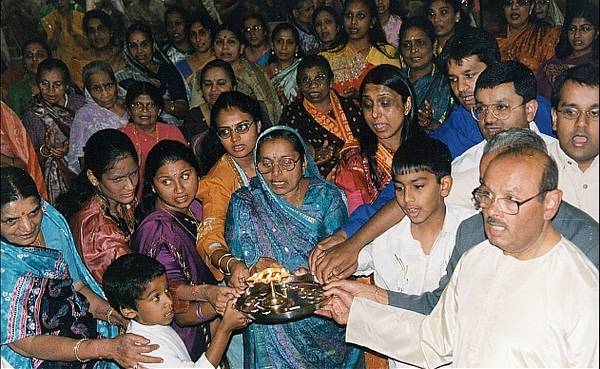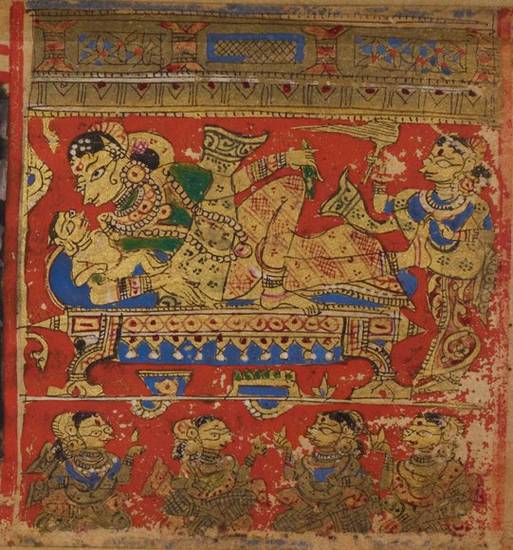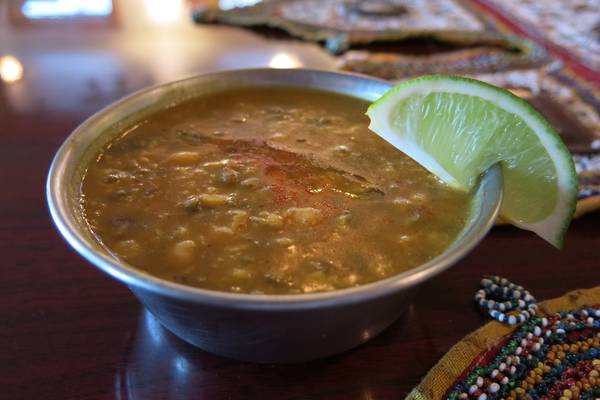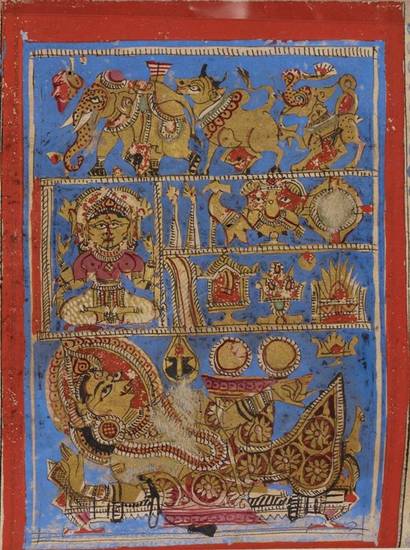Article: Paryuṣaṇ
Paryuṣaṇ is the most important Śvetāmbara Jain festival. It falls in late August or early September on the cusp of the months Śrāvaṇ and Bhādarvā, and lasts eight days.
This festival begins the winding down of the year in the traditional calendar. The end of the old year and the start of the new year is celebrated at Divālī some weeks later.
Paryuṣaṇ features increased ritual observance and participation, particularly in sermons and fasting. Public recitation of the Kalpa-sūtra, fasting and restricted eating, greater focus on religious obligations, and auctions centred around religious objects or activities to raise funds are all characteristics of this festival. Communities celebrate Paryuṣaṇ in activities at both the temple and at home. It is an important public event that demonstrates active membership of both a local congregation and the wider sect of Śvetāmbara Jains.
Digambara Jains celebrate a similar festival called Daśa-lakṣaṇa-parvan, beginning the day after Paryuṣaṇ is completed.
Days and main events of Paryuṣaṇ
The festival of Paryuṣaṇ – often known as Paryushan to contemporary Jains – is the main Śvetāmbara Jain festival. It falls in late August or early September on the cusp of the months Śrāvaṇ and Bhādarvā. Most Śvetāmbara groups celebrate the festival from Śrāvaṇ dark 14th through to Bhādarvā bright 5th. However, the Tapā-gaccha Jains celebrate the festival one day earlier, beginning on Śrāvaṇ dark 13 and ending on Bhādarvā bright 4.
Paryuṣaṇ lasts eight days, with certain rituals taking place at set times. The two central festival days are Mahāvīr Janam Dīvas, on the fifth day, and Saṃvatsarī, which is on the last day. These two days see celebrations involving the whole congregation.
Mahāvīr Janam Dīvas, or the celebration of the birth of Mahāvīra, centres around the public recitation of the Kalpa-sūtra text of the birth of Mahāvīra and the public veneration of objects showing significant scenes and symbols in the story. Taking part in Mahāvīr Janam Dīvas celebrations marks one’s membership of a particular congregation.
On Saṃvatsarī Śvetāmbara Jains perform the annual rite of confession. It is expected that all Jains take part unless they physically cannot participate. Attending the ritual of confession indicates a lay Jain’s membership in the wider Śvetāmbara Jain community.
Paryuṣaṇ is notable for the following points:
- the central place given to the Kalpa-sūtra
- the emphasis on fasting and restrictions on eating
- the paying of more attention to religious obligations, especially fulfilling five specific duties
- the important role of religious auctions.
Kalpa-sūtra
At the centre of the annual festival of Paryuṣaṇ is the recitation of the fifth-century Kalpa-sūtra and its 17th-century commentary. This commentary is a translation into Gujarati of the Sanskrit commentary of Vinayvijay. The recitation takes five days and has three rituals or observances that are particularly significant.
The first observance takes place on the fourth day of the festival. It consists of the procession of the Kalpa-sūtra manuscript to the location where the recitations will be performed and then the opening performances.
The second ritual is in the afternoon on the fifth day of the festival. It is the recitation of the story of the conception and birth of Mahāvīra, as told in the Kalpa-sūtra. Monks may also display pictures of the story to the congregation. This day – Mahāvīr Janam Dīvas – revolves around the celebration of Mahāvīra‘s birth.
The third observance takes place in the morning of the eighth and last day of the festival. It is the auspicious unbroken recitation of the core text of the Kalpa-sūtra, the ‘Barsā-sūtra’ – the ‘1200 verses’.
Fasting during Paryuṣaṇ
Both lay and mendicant Jains limit the types and amounts of food they eat. A vegetarian diet is the cornerstone of Jain restrictions on food while fasting is widespread, particularly for lay women and ascetics. Restrictions on food and fasting are often the focus of vows that both lay and ascetic Jains may take.
It is particularly common for Jains to introduce extra food restrictions or to complete fasts during Paryuṣaṇ. At the least, all those who take part in the annual rite of confession are expected to fast the night before the ceremony. However, most Jains will perform some kind of food restrictions beyond this. For example, most families will give up all vegetables during the eight days of the festival, living entirely on grains, pulses and dairy products. In addition, on any given day – most commonly the first and last day of Paryuṣaṇ – many Jains will perform a full fast or a version of limited eating.
The fasts most associated with Paryuṣaṇ are the three-day fast – Aṭhṭham – and the more difficult eight-day fast – Aṭhṭhāī. During these fasts, the faster takes only water and even the times for drinking water are limited.
These fasts and other longer fasts are organised to end at the same time as the fast-breaking on the morning after Saṃvatsarī, the last day of the festival.
Religious obligations during Paryuṣaṇ
Paryuṣaṇ has a set of five religious obligations that is emphasised in daily sermons, especially on the first days of the festival. They are:
- to stop killing – amārī pravārtan
- to show affection for other Jains – sādharmik vātsalya
- to perform a formulaic apology – kṣamāpanā
- to complete a three-day fast – aṭhṭham tap
- to go on pilgrimage – caitya paripāṭī.
Most Jains try to at least partly fulfil these obligations. For example, the obligation to stop killing might be met by contributing to charitable organisations, supporting animal rights or by publishing an advertisement to encourage vegetarianism. Affection for other Jains is shown primarily through sponsoring and attending communal meals for one’s own congregation or through giving out tokens of affection and appreciation, including coins, sweets or gifts at events during the festival. Even though most Jains do not perform the three-day fast, many will undertake some kind of fasting during Paryuṣaṇ.
Throughout the festival, Śvetāmbara Jains make a special effort to uphold ritual observances. For example, many Jains make a point of worshipping daily at their temple, attending sermons by resident monks or nuns and, at the least, fasting after the confession on Saṃvatsarī. Congregations that have mendicants staying for the rainy season will hear additional sermons. Where no mendicant is in residence, congregations will often invite a mendicant to give sermons for these eight days.
Religious auctions
One Jain practice that is especially visible at Paryuṣaṇ is the bolī or religious auction. Lay Jains bid for the privilege of performing certain rituals or of supplying the materials needed to run a temple. The public auction is a prestigious way to fulfil the Jain religious obligation to support Jain institutions. Though Jains are not required to make public donations, the public nature of the Paryuṣaṇ auctions encourages everyone to donate and helps to glorify the tradition at the same time.
The auctions allow Jain lay people to fulfil their obligation to religious institutions and promote Jain values through donation. Those who give money through the auctions gain personal merit through donation. They also create more chances for gaining merit for themselves and others by establishing and supporting the institutions which make possible the full practices of Jainism.
On a practical level, the auctions serve to supply the running budget for the temple for the year ahead. They also provide extra funds from which the congregation can draw to make charitable contributions as a group or to add to and repair the temple and its surroundings.
While auctions often take place for the rituals carried out each day during the festival, the grandest and most public auction is that performed at Mahāvīr Janam Dīvas.
Mahāvīr Janam Dīvas

Paryuṣaṇ lamp ceremony
Image by Chandu Shah © Chandu Shah
Though Mahāvīra’s official date of birth is in the spring, Mahāvīr Janam Dīvas, or the celebration of the birth of Mahāvīra, is a spectacle revolving around the birth of the 24th Jina. On the fifth day of Paryuṣaṇ a prominent ascetic recites the passages of the Kalpa-sūtra that tell the story of Mahāvīra’s conception and birth to the whole local community. The lay Jains publicly venerate objects representing the conception and birth.
The most significant rituals associated with Mahāvīr Janam Dīvas are the auctions – bolīs – that are run to decide the privilege of carrying out certain ceremonies.
On Mahāvīr Janam Dīvas, the morning recitation of the Kalpa-sūtra stops just before the story of Mahāvīra’s conception and birth. The congregation then returns home and prepares for the afternoon’s celebration. Women and children dress in their finest clothing. Soon after lunch the congregation gathers in a hall for the main event. The afternoon’s recitation of the birth of Mahāvīra is embedded in a series of rituals, of which the auctions form a key part.
Fourteen dreams
During her pregnancy, Mahāvīra’s mother experiences 14 dreams, which are the focus of much of the ritual activity of Mahāvīr Janam Dīvas. The dreams are:
- an elephant
- a bull
- a lion
- the goddess Lakṣmī
- a flower garland
- the moon
- the sun
- a temple
- a water pot
- a lotus lake
- an ocean of milk, usually signified by a ship
- a heavenly chariot
- a pile of gems
- a flame.
These dreams are each pictured on 14 silver or gold plaques, which are venerated in turn.
There are bids to perform various rites associated with the 14 dreams, such as garlanding each plaque with flowers and carrying it to the display table. Leading families try to win at least one of the number of auctions that takes place at this point in the day, as a mark of their piety and prestige. The most significant and expensive auction regards the honour of being the family who takes home the image of the baby Mahāvīra for the last three days of the festival.
After the dreams have been venerated and all of the auctions completed, the Kalpa-sūtra recitation continues to the birth of Mahāvīra. At this point, men in the congregation break coconuts to mark Mahavira’s birth and feed pieces of these coconuts to each other in celebration. The congregation will also all push forward to have the chance to rock the silver image of the cradle holding the newborn Mahāvīra.
After the auctions and associated rituals, many Jains will attend the evening lamp offering in the temple. Mahāvīr Janam Dīvas and Saṃvatsarī are often the nights with the most elaborate temple decorations.
Śvetāmbara Jains focus their celebration of Mahāvīra’s birth on Mahāvīr Janam Dīvas rather than on Mahāvīr Jayanti. Taking place in the spring, this latter festival remains a minor holiday with few extra observances.
Saṃvatsarī

Breaking a fast
Image by Chandu Shah © Chandu Shah
The last day of Paryuṣaṇ is called Saṃvatsarī. On this, the eighth day of the festival, Śvetāmbara Jains perform the annual rite of confession. It involves reciting the Saṃvatsarī confession, or pratikramaṇ, preferably while taking part in the gathering of local devotees. The recitation takes several hours and includes confessing and doing penance for all the possible errors one might have made during the past year.
It is expected that all Jains perform this rite unless they are physically unable to carry out the ritual.
At the start of the ritual Jains begin a total fast until the following morning. This fast, alongside the longer Paryuṣaṇ-related fasts, is broken on the morning following Saṃvatsarī. For those who have performed longer fasts, fast-breaking celebrations are organised in which family and friends of the person completing a fast ceremonially feed the faster and gain merit by doing so. In some communities, those who have finished lengthy fasts are brought on a parade around the city on the day after Saṃvatsarī.
As part of this confession ritual, Jains say the Prakrit phrase Micchāmi Dukkaḍaṃ. This means ‘May no harm come from my actions’ and fulfils the requirement of formulaic apology that is part of the duties of Paryuṣaṇ. This apology is recited to all beings and then to the whole congregation.
Following the ritual confession, Jains will usually greet each other with a related saying: Boli Cali Micchāmi Dukkaḍaṃ. This means ‘Let no harm come from anything that was said or done’. Many will try to see as many of their family members, friends and work acquaintances as possible in the next few days to repeat this greeting to them. If they cannot meet in person, Jains will usually make phone calls and send letters expressing the same sentiment.
Reading
- Absent Lord: Ascetics and Kings in a Jain Ritual Culture
Lawrence A. Babb - Comparative Studies in Religion & Society series; volume 8
University of California Press; Berkeley, California, USA; 1996
- ‘Competing to Give, Competing to Get: Gujarati Jains in Britain’
Marcus Banks - Black and Ethnic Leaderships in Britain: The Cultural Dimensions of Political Action
edited by Pnina Werbner and Muhammad Anwar
Routledge Curzon Press; London, UK; 1991
- Organizing Jainism in India and England
Marcus Banks - Oxford Studies in Social and Cultural Anthropology series; volume 3
Clarendon Press; Oxford, UK; 1992
- ‘Śvetāmbar Mūrtipūjak Jain Scripture in a Performative Context’
John E. Cort - Texts in Context: Traditional Hermeneutics in South Asia
edited by Jeffrey R. Timm
State University of New York Press; Albany, New York, USA; 1992
- Jains in the World: Religious Values and Ideology in India
John E. Cort - Oxford University Press USA; New York, USA; 2001
- ‘The Jain merchant castes of Rajasthan: Some aspects of the management of social identity in a market town’
Christine M. Cottam Ellis - The Assembly of Listeners: Jains in Society
edited by Michael Carrithers and Caroline Humphrey
Cambridge University Press; Cambridge, England UK; 1991
- History, Scripture and Controversy in a Medieval Jain Sect
Paul Dundas - Routledge Advances in Jaina Studies series; series editor Peter Flügel; volume 2
Routledge Curzon Press; London, UK; 2007
- Scripture and Community: Collected Essays on the Jains
Kendall W. Folkert - edited by John E. Cort
Studies in World Religions series; volume 6
Center for the Study of World Religions, Harvard University & Scholars Press; Atlanta, Georgia, USA; 1993
- The Archetypal Actions of Ritual: A Theory Illustrated by the Jain Rite of Worship
Caroline Humphrey and James Laidlaw - Oxford Studies in Social and Cultural Anthropology series
Clarendon Press; Oxford, England UK; 1994
- Heroic Wives: Rituals, Stories and the Virtues of Jain Wifehood
M. Whitney Kelting - Oxford University Press USA; New York, USA; 2009
- Singing to the Jinas: Jain Laywomen, Maṇḍaḷ Singing and the Negotiations of Jain Devotion
M. Whitney Kelting - Oxford University Press USA; New York, USA; 2001
- ‘Tournaments of Honor: Jain Auctions, Gender, and Reputation’
M. Whitney Kelting - History of Religions
volume 48: 4
2009
- Riches and Renunciation: Religion, Economy and Society among the Jains
James Laidlaw - Oxford Studies in Social and Cultural Anthropology series
Oxford University Press; Oxford, UK; 1995
- Honour, Nurture and Festivity: Aspects of Female Religiosity amongst Jain Women in Jaipur
Josephine Reynell - PhD dissertation submitted to University of Cambridge in 1985
- ‘Renunciation and Ostentation: A Jain Paradox’
Josephine Reynell - Cambridge Anthropology
volume 9: 3
1995
- ‘Women and the Reproduction of the Jain Community’
Josephine Reynell - The Assembly of Listeners
edited by Michael Carrithers and Caroline Humphrey
Cambridge University Press; Cambridge, UK; 1991
- ‘Religious Practice and the Creation of Personhood among Śvetāmbar Mūrtipūjak Jain Women in Jaipur’
Josephine Reynell - Studies in Jaina History and Culture: Disputes and Dialogues
edited by Peter Flügel
Routledge Advances in Jaina Studies series; volume 1
Routledge Curzon Press; London, UK; 2006
- Guardians of the Transcendent: An Ethnography of a Jain Ascetic Community
Anne Vallely - University of Toronto Press; Toronto, Canada; 2002
Links
- Mahāvīr Janam Divas celebration
-
This YouTube slideshow of the celebrations of Paryuṣaṇ in Melbourne, Australia in 2010 illustrates some of the features of the eight-day long festival. Sculptures of the 14 auspicious dreams experienced by Mahāvīra’s mother are suspended from the ceiling on the fifth day of Paryuṣaṇ – Mahāvīr Janam Divas, which celebrates the birth of Mahāvīra, the 24th Jina. The sculptures are venerated in turn by all the festival participants, sometimes by being held to the crown of the head, seat of spirituality in Indian culture. Then auctions – bolī – are held to decide who should perform various ceremonies. The most important and expensive auction is over the right to take home the image of the infant Mahāvīra for the last three days of the festival. Everyone can rock the cradle holding the idol of the baby Jina, which takes pride of place in the display.
- Paryuṣaṇ recipes
-
Recipes suitable for cooking during the Śvetāmbara festival of Paryuṣaṇ from the ramkicooks blog. During this annual festival of eight days, observant Jains tend to follow stricter than normal rules regarding food. Most families give up fresh vegetables, eating only grains, pulses and dairy produce. Taking additional vows to fast completely or partly for any given day of the festival, particularly the first and last days, is common.
- Re-enactment of the story of Candanabālā
-
This slideshow displays the re-enactment of the story of Candanabālā, who offered Mahāvīra appropriate food to break his fast. Sold into slavery, the beautiful princess has her lovely hair chopped off and is starved for three days. Even so, her first act when released is to offer alms to a passing mendicant. He is Mahāvīra, who becomes the 24th Jina, and he has been fasting for nearly six months. Candanabālā’s act of selfless charity despite her suffering causes her hair to be restored and her true identity revealed. The story of this virtuous woman – one of the soḷa satī – emphasises the importance of offering alms correctly. Acting out such stories is an important part of many Jain festivals. This re-enactment on YouTube was performed by Śvetāmbara Jains in Melbourne, Australia during the festival of Paryuṣaṇ in 2010.
- Paryuṣaṇ in the United States
-
The Pluralism Project at Harvard offers a short essay on the festival of Paryuṣaṇ, called 'Paryushan and the Festival of Forgiveness'. It focuses on contemporary Jainism in the United States.
https://pluralism.org/paryushana-and-the-festival-of-forgiveness
- Svastika during Paryuṣaṇ
-
A svastika formed out of traditional clay lamps – dīpas in Sanskrit – is arranged on the petal-strewn floor of a temple during the festival of Paryuṣaṇ. The svastika is an ancient symbol of good luck and is frequently found in Jain temples, on religious equipment and on books, clothing and so on. The four dots among the arms of the svastika represent either the four states of existence or the parts of the fourfold community. Lasting eight days in late August or early September, Paryuṣaṇ is the most important Śvetāmbara Jain festival. This photograph on Flickr was taken in 2007.
- Supreme Court upholds a Paryuṣaṇ ban
-
Details of the Supreme Court of India's 2008 ruling to uphold the state government of Gujarat's ban on the operation of slaughterhouses and butchers during the Jain festival of Paryuṣaṇ. The CAclubindia.com provides this information in its Judiciary section.
- Report of Supreme Court decision to uphold Paryuṣaṇ ban
-
IBN Live news website reports the 2008 ruling of the Supreme Court of India to uphold the decision of the state government of Gujarat to ban the operation of slaughterhouses, butchers and fisheries during the festival of Paryuṣaṇ. The 2008 article includes a video of the television news report, which features a phone interview with the legal correspondent in New Delhi. He explains the history of the legal case and possible wider applications of the ruling throughout India.
http://ibnlive.in.com/news/gujarat-meat-eaters-can-abstain-out-of-respect-sc/61275-3.html
- +
- aAbhavya
- aAbhinandana
- aAbhiṣeka
- aĀcāra
- aĀcārāṅga-sūtra
- aĀcārya
- aAchalbhrata
- aAḍhāī-dvīpa
- aAdharma
- aAdho-loka
- aAdhyayana
- aAdvaita Vedānta
- aĀgama
- aAghātīya
- aAghātīya-karman
- aAgnibhuti
- aAgra
- aĀhāra
- aAhiṃsā
- aAhimsa Day
- aAjita
- aAjīva
- aAkampit
- aĀkāśa
- aAkbar the Great
- aAkṣaya-tṛtīyā
- aAlauddin Khalji
- aAlbert Einstein
- aAllah
- aAlms
- aĀlocanā
- aAloka-ākāśa
- aAmāri
- aAmbikā or Kūṣmāṇḍinī
- aAnagāra
- aAnanta
- aAnarthadaṇḍa
- aAnaśana
- aAnekānta-vāda
- aAṅga
- aAniconism
- aAnojjā
- aAntarāla
- aAntarāya-karma
- aAṇu
- aAṇu-vrata
- aAnukampā
- aAnuprekṣā
- aAnusvāra
- aApabhraṃśa
- aAparigraha
- aAra
- aĀrambha
- aĀrambhaja
- aĀratī
- aArdhamāgadhī Prākrit
- aArhaṃ
- aArhat
- aArśana-āvaraṇīya-karma
- aĀrta-dhyāna
- aĀryikā
- aĀryikā Jñānamati
- aĀśātanā
- aĀścarya
- aAscetic
- aAsceticism
- aAshram
- aAspiration
- aĀsrava
- aAṣṭa-maṅgala
- aAṣṭāpada
- aAstikāya
- aAstrolabe
- aAsura
- aAtheism
- aAticāra
- aAtiśayakṣetra
- aAtithisaṃvibhāgavrata
- aĀtma-vāda
- aĀtman
- aAuṃ
- aAurangzeb
- aAuspicious
- aAusterity
- aAvadhāna
- aAvadhi-jñāna
- aĀvaraṇī-yakarman
- aAvasarpiṇī
- aAvatāra
- aAvidyā
- aAxiom
- aĀyāga-paṭa
- aĀyambil
- aĀyu-karma
- aĀyurveda
- bBabur
- bBāhubali
- bBaladeva
- bBālāvabodha
- bBandha
- bBasadi
- bBazaar
- bBhadrankarvijay
- bBhagavant
- bBhaktāmara-stotra
- bBhakti
- bBhale
- bBharata
- bBhāṣā
- bBhāṣya
- bBhaṭṭāraka
- bBhāva
- bBhāva-pūjā
- bBhāvanā
- bBhavana-vāsin
- bBhavya
- bBhavyatva
- bBhaya
- bBhoga-bhūmi
- bBhogopabhoga
- bBodhi
- bBollywood
- bBrahmā
- bBrahma-deva
- bBrahmacārī
- bBrāhmaṇa
- bBraj Bhāṣā
- bBright fortnight
- bBritish Raj
- bBuddha
- bBuddhi-sagar
- bBuddhism
- bBuddhist
- cCaitya
- cCaityavāsin
- cCakravartin
- cCakreśvarī
- cCāmara
- cCandanā
- cCandragupta
- cCandraprabha
- cCanon
- cCāritra
- cCāritramohanīya-karman
- cCarũrī
- cCaste
- cCaturvidha-saṅgha
- cCaturviṃśati-stava
- cCāturyāma
- cCE
- cCelibacy
- cCha
- cChadmastha
- cChastity
- cCheda-sūtra
- cChristian
- cChristianity
- cClergy
- cCloning
- cColophon
- cCommentary
- cConch
- cConfession
- cCongregation
- cConsecration
- cCosmology
- cCremation
- cCrore
- cCult
- cCūrṇi
- dDādā-guru
- dDalit
- dDāna
- dDaṇḍa
- dDark fortnight
- dDarśana
- dDarśanamohanī-yakarman
- dDaśa-lakṣaṇa-parvan
- dDeity
- dDelhi Sultanate
- dDerāsar
- dDeśāvakāśika-vrata
- dDetachment
- dDevanāgarī
- dDevānandā
- dDevarddhi-gani
- dDevotee
- dDhamal
- dDhanuṣ
- dDhāra
- dDharma
- dDharma-dhyāna
- dDharma-sāgara
- dDharmastikaya
- dDhātakīkhaṇḍa
- dDholak
- dDhyāna
- dDiaspora
- dDig-vrata
- dDigambara
- dDīkṣā
- dDisciple
- dDīvālī
- dDivya-dhvani
- dDNA
- dDoctrine
- dDogma
- dDonor
- dDoṣa
- dDravya
- dDravya-pūjā
- dDrone
- dDuṣamā
- dDuṣamā-duṣamā
- dDuṣamā-suṣamā
- dDveṣa
- dDvīpa
- eEast India Company
- eEightfold Path
- eEkānta-vāda
- eEkendriya
- eElder
- eElders
- eEschatology
- eEtc up to
- fFarmān
- fFast
- fFatehpur Sikri
- fFestival
- fFestschrift
- fFiruz Shah
- fFly-Whisks
- fFolio
- fFour Noble Truths
- gGaccha
- gGaṇa
- gGaṇadhara
- gGanadharavada
- gGaṇeśa
- gGaṇin
- gGarba
- gGarbha
- gGarbha-gṛha
- gGaruḍa
- gGati
- gGene
- gGenomics
- gGhātī-yakarman
- gGhātīya
- gGhaznavid
- gGhiyasuddin Tughlaq
- gGhurid
- gGloss
- gGotra-karma
- gGujarāt
- gGujarati
- gGuṇa
- gGuṇa-sthāna
- gGuṇa-vrata
- gGupti
- gGuru
- gGuruṇī
- hHagiography
- hHajj
- hHaṃsa
- hHaribhadra
- hHariṇaigameṣin
- hHasta
- hHeresy
- hHiṃsā
- hHindi
- hHindu
- hHinduism
- hHīravijaya
- hHoroscope
- hHrīṃ
- hHumayun
- hHymn
- iIconoclasm
- iIconography
- iIdol
- iIndian Independence
- iIndology
- iIndra
- iIndrabhūti Gautama
- iIndriya
- iInitiation
- iIntercession
- iInvocation
- iIQ
- iIslam
- iIslamicate
- iIṣṭadevatā
- iĪśvara
- jJagat
- jJahangir
- jJain
- jJaina Devanāgarī
- jJaina Śaurasenī
- jJaina-dharma
- jJainaśāsana
- jJainness
- jJaisalmer
- jJamāli
- jJambū-dvīpa
- jJames Burgess
- jJanma
- jJanma-kalyāṇa
- jJarā
- jJāti
- jJina
- jJina-āgama
- jJina-bhavana
- jJina-bimba
- jJina-mātā
- jJinacandra-sūri
- jJinadatta
- jJinaprabha
- jJīva
- jJñāna
- jJñāna-āvaraṇīya-karma
- jJñāna-āvarṇiya
- jJñānsundar
- jJyotiṣka
- kKāla
- kKālakācārya-kathā
- kKālidāsa
- kKalpa-sūtra
- kKalpa-vṛkṣa
- kKalyāṇaka
- kKalyanvijay
- kKamaṇḍalu
- kKamaṭha
- kKarma
- kKarma-bhūmi
- kKarma-grantha
- kKarma-prakṛti
- kKarma-vāda
- kKarmon
- kKarnataka
- kKaṣāya
- kKathā
- kKāvya
- kKāya
- kKāyotsarga
- kKeśa-loca
- kKetu
- kKevala-jñāna
- kKevalin
- kKhalji
- kKharatara-gaccha
- kKnowledge
- kKriyā
- kKriyā-vāda
- kKṛṣṇa
- kKṣamā-śramaṇa
- kKṣapakaśreṇi
- kKṣatriya
- kKṣullaka
- kKulakara
- kKundakunda
- kKunthu
- lLabdhi
- lLaity
- lLakh
- lLāñchana
- lLands of Action
- lLaukāntika
- lLavaṇa-samudra
- lLeśyā
- lLiṅga
- lLinguistics
- lLoka
- lLoka-ākāśa
- lLoka-puruṣa
- lLoka-vāda
- lLotus
- lLotus lake
- mMadhya-loka
- mMahā-videha
- mMahā-vrata
- mMahābhārata
- mMahāmastakābhiṣeka
- mMāhārāṣṭra
- mMāhārāṣṭrī Prākrit
- mMahattarā Yākinī
- mMahāvīr Jayantī
- mMahāvīra
- mMakāra
- mMakkhali Gośāla
- mMalli
- mMāna-stambha
- mManaḥ-paryāya-jñāna
- mMaṇḍala
- mMaṇḍapa
- mMandit
- mMaṅgala
- mMantra
- mMantras
- mManuṣya-loka
- mMarāṭhī
- mMārgaṇā
- mMartyr
- mMarudevī
- mMaṭha
- mMati-jñāna
- mMauryaputra
- mMecca
- mMendicant lineage
- mMetarya
- mMiracle
- mMithyādṛṣṭi
- mMohandas Gandhi
- mMohanīya-karma
- mMokṣa
- mMonastic order
- mMonasticism
- mMonk
- mMonotheism
- mMosque
- mMount Meru
- mMount Sammeta
- mMṛgāvatī
- mMughal
- mMuhammad
- mMuhammad bin Tughlaq
- mMuhpattī
- mMūla-sūtra
- mMūlaguṇa
- mMumbaī
- mMuni
- mMunisuvrata
- mMurad Bakhsh
- mMūrti-pūjaka
- mMuslim
- mMysticism
- nNābhi
- nNāga-kal
- nNāgapurīya Tapā-gaccha
- nNāgarī
- nNāma-karma
- nNamaskāra-mantra
- nNami
- nNandīśvara-dvīpa
- nNandivardhana
- nNandyāvarta
- nNāraka
- nNāraki
- nNasalisation
- nNātha
- nNavrātrī
- nNaya-vāda
- nNemi
- nNidāna
- nniggaṃthāṇa vā 2
- nniggaṃtho vā 2
- nNigoda
- nNihnava
- nNikṣepa
- nNirgrantha
- nNirjarā
- nNirvāṇa
- nNiryukti
- nNiṣidhi
- nNitya
- nNiyati
- nNo-kaṣāya
- nNudity
- nNun
- oOcean of milk
- oOmniscience
- oOrdination
- ppa°
- pPadmaprabha
- pPadmāsana
- pPadmāvatī
- pPādukā
- pPalanquin
- pPalette
- pPañca-muṣṭi
- pPāṇḍava
- pPaṇḍit
- pPandit Dalsukh D. Malvania
- pPandit Sukhlalji
- pPāṇipātra
- pPāpa
- pParamātman
- pParameṣṭhin
- pPāraṇā
- pParigraha
- pPariṇāma
- pParīṣaha
- pParokṣa
- pPārśva
- pPārśvanātha
- pParyāya
- pParyuṣaṇ
- pPaṭa
- pPatan
- pPātra
- pPenance
- pPersian
- pPhala
- pPhilology
- pPicchikā
- pPilgrimage
- pPīr
- pPolymath
- pPoṣadha
- pPossession
- pPothī
- pPrabhas
- pPradakṣiṇā
- pPradeśa
- pPrākāra
- pPrakīrṇaka-sūtra
- pPrākrit
- pPramāda
- pPramukhā
- pPrati-vāsudeva
- pPratikramaṇa
- pPratimā
- pPratiṣṭhā
- pPratyākhyāna
- pPratyakṣa
- pPravacana
- pPrāyaścitta
- pPrayer
- pPre-modern
- pPreach
- pPredestination
- pProtestant
- pProvenance
- pPudgala
- pPūjā
- pPujārī
- pPukharavara-dvīpa
- pPuṇya
- pPūrva
- pPuṣkara-dvīpa
- pPuṣpadanta
- pPyre
- qQur’an
- rRāga
- rRāhu
- rRainy season
- rRajasthan
- rRajasthani
- rRājimatī
- rRajoharaṇa
- rRajput
- rRāma
- rRāmāyaṇa
- rRangoli
- rRās-garbā
- rRasa
- rRathanemi
- rRatna-traya
- rRātri-bhojana
- rRaudra-dhyāna
- rRecto
- rRelic
- rRenunciation
- rRetroflex
- rRevatī
- %Ṛg-veda
- rRite
- rRosary
- %Ṛṣabha
- %Ṛṣabhanātha
- rRupee
- sSaciyā Mātā
- sSādhu
- sSādhvī
- sSāgāra
- sSaint
- sŚaivaism
- sŚaka-saṃvat
- sSallekhanā
- sŚalya
- sSamacatuṣṭha
- sSamādhimaraṇa
- sSamaṇi
- sSāmarambha
- sSamavasaraṇa
- sSāmāyika
- sSaṃbhava
- sSamiti
- sSaṃjñā
- sSaṃkalpaja
- sSaṃsāra
- sSamudghāta
- sSaṃvara
- sSaṃvega
- sSamyak-cāritra
- sSamyak-darśana
- sSamyak-jñāna
- sSamyaktva
- sSaṃyama
- sSanctuary
- sSandalwood
- sSaṇgha
- sSanskrit
- sSant
- sŚānti
- sSapta-bhaṅgi-naya
- sSārambha
- sSarasvatī
- sSarvajña
- sSāsan-devi
- sŚāsana-devatā
- sŚāstra
- %Ṣaṭ-jīvanikāya
- sSatī
- sSatīmātā
- sSatya
- sSchism
- sScribe
- sScripture
- sSect
- sSecularism
- sŚenāī
- sSermon
- sŚeṣavatī
- sSevā
- sSeven fields of donation
- sShah Jahan
- sShantidas Jhaveri
- sShrine
- sSiddha
- sSiddha-śilā
- sSiddhacakra or Navadevatā
- sSiddhānta
- sSiddhārtha
- sSiddhi
- sSikh
- sSikhism
- sŚikṣā-vrata
- sŚīla
- sSin
- sSindh
- sŚītala
- sŚiva
- sSkandha
- sSomanatha
- sŚraddhā
- sŚramaṇa
- sŚrāvaka
- sŚrāvakācāra
- sŚrāvikā
- sŚreyāṃsa
- sŚrī
- sŚrīvatsa
- sŚruta-jñāna
- sŚruta-pañcamī
- sSthānaka-vāsin
- sSthāpanācārya
- sSthāvara
- sSthavira
- sSthiti
- sStrīmukti
- sStūpa
- sSubcontinent
- sSudarshana
- sŚuddhi
- sSudharma
- sŚūdra
- sSufism
- sSukha
- sŚukla-dhyāna
- sSulasā
- sSultan
- sSumati
- sSundarśrī
- sSupārśva
- sSūri
- sSuṣamā
- sSuṣamā-duṣamā
- sSuṣamā-suṣamā
- sSūtra
- sSuyam me ausam! Tenam bhagavaya evamakkhayam
- sSvādhyāya
- sSvāhā
- sSvastika
- sŚvetāmbara
- sŚvetāmbara Terāpanthin
- sŚvetāmbaras
- sSwan
- sSyād-vāda
- tTabla
- tTantra
- tTapā-gaccha
- tTapas
- tTāraṇ Svāmī Panth
- tTattva
- tTattvārtha-sūtra
- tTemple
- tTemple-city
- tThe Enlightenment
- tTheology
- tThree worlds
- %Ṭīkā
- tTilaka
- tTīrtha
- tTīrthaṃkaranāma-karman
- tTīrthankara
- tTransliteration
- tTrasa
- tTrasa-nāḍī
- tTriśalā
- tTriṣaṣṭi-śalākā-puruṣa-caritra
- tTti bemi
- tTughlaq
- tTunk
- uUdumbara
- uUniversal History
- uUpādhyāya
- uUpāṅga
- uUpaniṣads
- uUpāsaka
- uUpasarga
- uUpāśraya
- uŪrdhva-loka
- uUtsarpiṇī
- uUttarādhyayana-sūtra
- vVāhana
- vVaimānika
- vVairāgya
- vVaiṣṇava
- vVaiśramaṇa
- vVaiśya
- vValabhī
- vVanaspatikāya
- vVandana
- vVaṇik
- vVarṇa
- vVāsudeva
- vVāsupūjya
- vVayubhūti
- vVeda
- vVedanīya-karma
- vVegetarianism
- vVehicle
- vVernacular
- vVerso
- vVidyā
- vVidyā-devī
- vVihāra
- vVijñapti-patra
- vVikrama-saṃvat
- vVikṛti
- vVimala
- vVinaya
- vVipāka
- vVirji Vora
- vVirodhaja
- vVīrya
- vVisarga
- vViṣṇu
- vVītarāga
- vVizier
- vVotive
- vVow
- vVrata
- vVS
- vVyakta
- vVyantara
- vVyasana
- yYakṣa
- yYakṣī
- yYantra
- yYaśoda
- yYaśovijaya
- yYati
- yYātrā
- yYoga
- yYoginī
- yYojana















